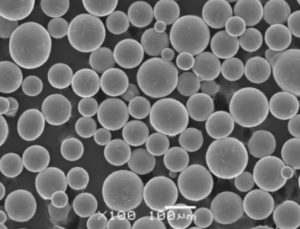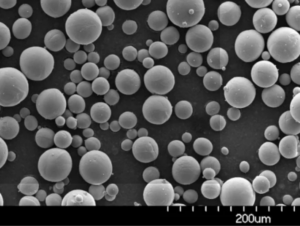Bu santrifüjlü atomizasyon işlemi yüksek derecede hassasiyet ve homojenliğe sahip ince metal tozları üretmek için kullanılan büyüleyici ve karmaşık bir tekniktir. Bu mükemmel küresel metal tozlarının nasıl yapıldığını merak ettiyseniz veya sürecin en ince ayrıntılarını merak ediyorsanız, doğru yerdesiniz. Kemerlerinizi bağlayın, çünkü santrifüj atomizasyon dünyasının derinliklerine dalıyor, içini dışını keşfediyor ve bu olağanüstü teknolojinin ardındaki sırları ortaya çıkarıyoruz.
Santrifüj Atomizasyon Sürecine Genel Bakış
Santrifüj atomizasyon, erimiş metalin dönen bir disk veya kap tarafından ince damlacıklara dönüştürüldüğü bir metal tozu üretim yöntemidir. Bu damlacıklar dışarı doğru fırlatıldıkça katılaşır ve küresel metal tozları elde edilir. Proses son derece kontrollüdür ve partikül boyutu dağılımı ve saflık gibi belirli özelliklere sahip tozların üretilmesine olanak tanır.
Anahtar Ayrıntılar
- Teknoloji: Santrifüj atomizasyon
- Birincil Kullanım: Metal tozlarının üretimi
- Çekirdek Mekanizma: Dönen disk veya fincan
- Sonuç: İnce, küresel metal tozları
- Uygulamalar: Katmanlı üretim, toz metalurjisi, kaplamalar ve daha fazlası
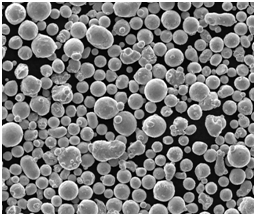
Bileşimi Santrifüj Atomizasyon Süreci
Santrifüj atomizasyon prosesinin yapısını anlamak, nasıl çalıştığını ve neden bu kadar etkili olduğunu kavramak için gereklidir.
| Bileşen | Açıklama |
|---|---|
| Erimiş Metal | Hammadde, tipik olarak alüminyum, titanyum, çelik veya nikel alaşımları gibi metaller. |
| Eğirme Cihazı | Erimiş metali dağıtmak için yüksek hızlarda dönen bir disk veya kap. |
| Soğutma Ortamı | Genellikle metal damlacıkları soğutan ve katılaştıran inert bir gaz veya hava. |
| Koleksiyon Odası | Katılaşmış metal tozlarının toplandığı alan. |
| Kontrol Sistemleri | Sıcaklık, hız ve diğer parametrelerin izlenmesi ve ayarlanması için sistemler. |
Kullanılan Metal Türleri
Santrifüj atomizasyon yoluyla her biri benzersiz özelliklere ve uygulamalara sahip farklı metaller ve alaşımlar işlenebilir.
| Metal/Alaşım | Mülkler | Uygulamalar |
|---|---|---|
| Alüminyum Alaşımları | Hafif, korozyona dayanıklı | Havacılık ve uzay, otomotiv, tüketici elektroniği |
| Titanyum Alaşımları | Yüksek mukavemet/ağırlık oranı, biyouyumlu | Tıbbi implantlar, havacılık ve uzay |
| Paslanmaz Çelik | Korozyona dayanıklı, uzun ömürlü | Tıbbi cihazlar, endüstriyel ekipmanlar |
| Nikel Alaşımları | Isıya dayanıklı, korozyona dayanıklı | Türbinler, yüksek sıcaklıklı ortamlar |
| Bakır Alaşımları | İletken, şekillendirilebilir | Elektrikli bileşenler, ısı eşanjörleri |
Özellikleri ve Karakteristikleri Santrifüj Atomizasyon Süreci
Santrifüj atomizasyon ile üretilen tozların özellikleri, çeşitli endüstrilerdeki uygulamaları için çok önemlidir. Şimdi ana özellikleri inceleyelim.
| Mülkiyet | Açıklama |
|---|---|
| Parçacık Boyutu | Proses parametrelerine bağlı olarak tipik olarak birkaç mikrometre ile birkaç yüz mikrometre arasında değişir. |
| Şekil | Ağırlıklı olarak küreseldir, bu da akışkanlığı ve paketleme yoğunluğunu artırır. |
| Saflık | Kontrollü ortam ve minimum kontaminasyon sayesinde yüksek saflık. |
| Yoğunluk | Tutarlı malzeme özellikleri gerektiren uygulamalar için kritik olan tek tip yoğunluk. |
| Yüzey İşlemi | Katmanlı üretim ve kaplamalardaki uygulamalar için faydalı olan pürüzsüz yüzey kalitesi. |
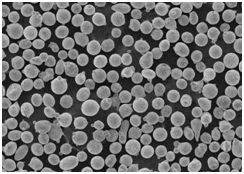
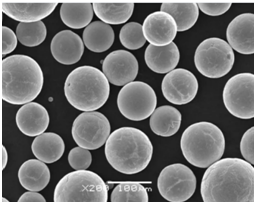
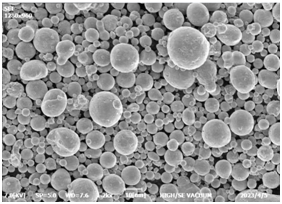

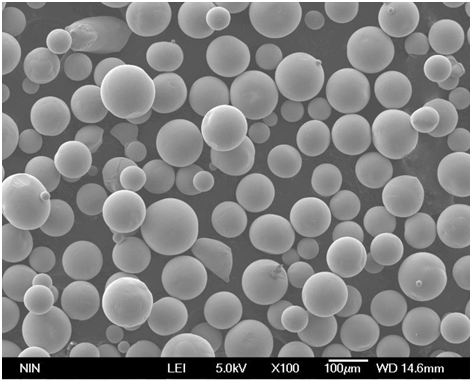
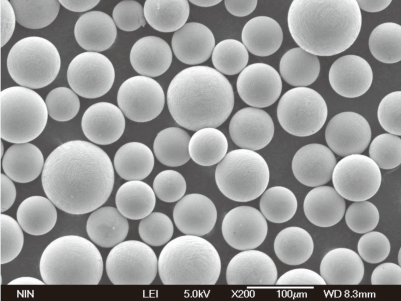
Santrifüj Atomizasyon Prosesi Sınıfları ve Standartları
Farklı dereceler ve standartlar, üretilen metal tozlarının çeşitli uygulamaların özel ihtiyaçlarını karşılamasını sağlar.
| Sınıf | Standart | Açıklama |
|---|---|---|
| A Sınıfı | ASTM B330 | Yüksek saflıkta, havacılık ve tıbbi uygulamalar için uygundur. |
| B Sınıfı | ISO 9001 | Standart kalite, genel endüstriyel uygulamalarda kullanılır. |
| C Sınıfı | AMS 4999 | Yüksek mukavemet ve dayanıklılık, genellikle otomotiv ve yapısal uygulamalarda kullanılır. |
| D Sınıfı | MIL-STD-3021 | Askeri standart, aşırı koşullar altında güvenilirlik sağlar. |
| E Sınıfı | JIS Z8901 | Elektronik ve hassas ekipmanlarda yaygın olarak kullanılan Japon endüstriyel standardı. |
Santrifüj Atomizasyon Prosesi Uygulamaları
Santrifüj atomizasyon ile üretilen metal tozlarının çok yönlülüğü, geniş bir uygulama yelpazesine kapı açmaktadır.
| Uygulama | Açıklama |
|---|---|
| Katmanlı Üretim | 3D baskıda yüksek hassasiyet ve minimum atık ile karmaşık geometriler oluşturmak için kullanılır. |
| Toz Metalurjisi | Karmaşık şekillere ve mükemmel mekanik özelliklere sahip metal parçaların şekillendirilmesinde kullanılır. |
| Termal Püskürtme | Aşınma direncini, korozyon direncini ve termal korumayı artırmak için kaplama yüzeylerinde kullanılır. |
| MIM (Metal Enjeksiyon Kalıplama) | Yüksek yoğunluk ve mukavemete sahip küçük, karmaşık parçaların üretilmesini sağlar. |
| Elektronik | Kondansatörler, indüktörler ve ısı alıcıları gibi bileşenlerin üretiminde kullanılır. |
Spesifik Metal Tozu Modelleri
Santrifüj atomizasyon yoluyla üretilen belirli metal tozu modellerini inceleyerek benzersiz özelliklerini ve uygulamalarını vurgulayalım.
1. Alüminyum Alaşımlı Toz (AlSi10Mg)
- Mülkler: Hafif, yüksek mukavemetli, iyi korozyon direnci
- Uygulamalar: Havacılık ve uzay bileşenleri, otomotiv parçaları, yüksek performanslı elektronikler
2. Titanyum Alaşımlı Toz (Ti6Al4V)
- Mülkler: Mükemmel biyouyumluluk, yüksek mukavemet/ağırlık oranı, korozyona dayanıklı
- Uygulamalar: Tıbbi implantlar, havacılık ve uzay parçaları, yüksek performanslı spor malzemeleri
3. Paslanmaz Çelik Tozu (316L)
- Mülkler: Korozyona dayanıklı, uzun ömürlü, iyi mekanik özellikler
- Uygulamalar: Tıbbi cihazlar, gıda işleme ekipmanları, kimyasal işleme
4. Nikel Alaşımlı Toz (Inconel 718)
- Mülkler: Yüksek sıcaklık ve korozyon direnci, iyi mekanik özellikler
- Uygulamalar: Türbin kanatları, yüksek sıcaklıkta havacılık bileşenleri, petrol ve gaz endüstrisi
5. Bakır Alaşımlı Toz (CuSn10)
- Mülkler: Mükemmel elektrik ve ısı iletkenliği, korozyona dayanıklı
- Uygulamalar: Elektrikli bileşenler, ısı eşanjörleri, rulmanlar
6. Kobalt-Krom Alaşımlı Toz (CoCrMo)
- Mülkler: Yüksek aşınma direnci, biyouyumluluk, mükemmel mekanik özellikler
- Uygulamalar: Diş implantları, ortopedik implantlar, havacılık ve uzay bileşenleri
7. Takım Çeliği Tozu (H13)
- Mülkler: Yüksek sertlik, mükemmel aşınma direnci, iyi termal kararlılık
- Uygulamalar: Enjeksiyon kalıpları, basınçlı döküm kalıpları, yüksek sıcaklık takımları
8. Magnezyum Alaşımlı Toz (AZ91D)
- Mülkler: Hafif, iyi mekanik özellikler, korozyona dayanıklı
- Uygulamalar: Otomotiv parçaları, havacılık ve uzay bileşenleri, hafif yapılar
9. Bronz Tozu (Cu10Sn)
- Mülkler: İyi aşınma direnci, korozyona dayanıklı, yüksek iletkenlik
- Uygulamalar: Rulmanlar, burçlar, elektrik kontakları
10. Yüksek Hızlı Çelik Tozu (M2)
- Mülkler: Yüksek sertlik, mükemmel aşınma direnci, iyi tokluk
- Uygulamalar: Kesici takımlar, matkap uçları, endüstriyel bıçaklar
Tedarikçiler ve Fiyatlandırma Detayları
Doğru tedarikçiyi seçmek ve fiyatlandırmayı anlamak, metal tozları tedarik etmek için çok önemlidir. İşte bazı önde gelen tedarikçilere ve fiyatlandırma detaylarına bir göz atın.
| Tedarikçi | Metal Tozu | Fiyatlandırma (kg başına) | Notlar |
|---|---|---|---|
| Höganäs AB | Alüminyum Alaşım (AlSi10Mg) | $50 – $70 | Katmanlı üretim için yüksek kaliteli tozlar. |
| Sandvik Osprey | Titanyum Alaşımı (Ti6Al4V) | $150 – $200 | Birinci sınıf, tıbbi ve havacılık uygulamaları için uygundur. |
| Marangoz Teknolojisi | Paslanmaz Çelik (316L) | $60 – $80 | Endüstriyel ve tıbbi uygulamalarda yaygın olarak kullanılır. |
| AMETEK Özel Metal Ürünleri | Nikel Alaşım (Inconel 718) | $200 – $250 | Zorlu ortamlar için yüksek performanslı tozlar. |
| GKN Hoeganaes | Bakır Alaşımı (CuSn10) | $30 – $50 | Elektrik uygulamaları için yüksek iletkenliğe sahip tozlar. |
| Kennametal | Takım Çeliği (H13) | $80 – $100 | Yüksek mukavemetli takım malzemeleri için güvenilir tedarikçi. |
| LPW Teknoloji | Yüksek Hız Çeliği (M2) | $100 – $150 | Kesici takımlar için yüksek kaliteli metal tozlarının lider tedarikçisi. |
| AP&C (bir GE Additive şirketi) | Kobalt-Krom (CoCrMo) | $300 – $350 | Tıbbi ve havacılık uygulamaları için birinci sınıf. |
| Praxair Yüzey Teknolojileri | Magnezyum Alaşımı (AZ91D) | $40 – $60 | Otomotiv ve havacılık uygulamaları için hafif tozlar. |
| Royal Metal Tozları | Bronz Tozu (Cu10Sn) | $20 – $40 | Endüstriyel uygulamalar için uygun maliyetli tozlar. |
Artıları ve Eksileri Santrifüj Atomizasyon Süreci
Her teknolojinin güçlü ve zayıf yönleri vardır. Santrifüj atomizasyon prosesinin avantajlarını ve sınırlamalarını karşılaştıralım.
Avantajlar
- Yüksek Saflık: Kontrollü ortam kontaminasyonu en aza indirerek yüksek saflıkta tozlar elde edilmesini sağlar.
- Düzgün Parçacık Boyutu: Proses, tutarlı partikül boyutu dağılımına sahip tozlar üretir.
- Küresel Parçacıklar: Partiküllerin küresel şekli akışkanlığı ve paketleme yoğunluğunu artırır.
- Çok Yönlülük: Çok çeşitli metaller ve alaşımlar için uygundur.
- Ölçeklenebilirlik: Endüstriyel üretim için ölçeklendirilebilir.
Sınırlamalar
- Maliyet: Ekipman ve teknoloji için yüksek ilk yatırım.
- Karmaşıklık: Proses parametrelerinin hassas kontrolünü gerektirir.
- Maddi Sınırlamalar: Tüm malzemeler santrifüjlü atomizasyon için uygun değildir.
- Enerji Tüketimi: Metalleri yüksek hızlarda eritme ve eğirme ihtiyacı nedeniyle yüksek enerji kullanımı.

SSS
| Soru | Cevap |
|---|---|
| Santrifüjlü atomizasyon nedir? | İnce, küresel metal tozları üretmek için erimiş metalin hızla döndürüldüğü bir işlemdir. |
| Hangi metaller kullanılabilir? | Yaygın metaller arasında alüminyum, titanyum, paslanmaz çelik, nikel alaşımları ve bakır bulunur. |
| Metal tozlarının kullanım alanları nelerdir? | Uygulamalar arasında eklemeli üretim, toz metalurjisi, termal püskürtme ve elektronik yer almaktadır. |
| Küresel parçacıkların faydaları nelerdir? | Küresel partiküller daha iyi akışkanlığa, paketleme yoğunluğuna ve homojenliğe sahiptir. |
| Partikül boyutu nasıl kontrol edilir? | Partikül boyutu, eğirme cihazının hızı ve soğutma oranları ayarlanarak kontrol edilir. |
| Saflık neden önemlidir? | Yüksek saflık, kritik uygulamalarda daha iyi performans ve güvenilirlik sağlar. |
| Metal tozları için maliyet aralığı nedir? | Maliyetler, yaygın alaşımlar için kg başına 20 $'dan yüksek performanslı malzemeler için kg başına 350 $'a kadar büyük ölçüde değişebilir. |
| Bir tedarikçiyi nasıl seçerim? | Kalite, güvenilirlik, maliyet ve uygulamanızın özel gereksinimleri gibi faktörleri göz önünde bulundurun. |
Sonuç
Santrifüj atomizasyon prosesi modern mühendisliğin bir harikasıdır ve benzersiz hassasiyet ve kalitede ince metal tozları üretmek için son derece kontrollü bir yöntem sunar. Havacılık ve otomotiv endüstrilerinden tıbbi uygulamalara ve ötesine kadar, bu işlemle üretilen metal tozları günümüzün gelişmiş üretim ortamında vazgeçilmezdir. İster deneyimli bir mühendis, ister meraklı bir hobici ya da ikisinin arasında bir kişi olun, bu süreci anlamak malzeme bilimi ve teknolojisi dünyasına dair değerli bilgiler sağlar.
Unutmayın, sürecin kendisi karmaşık görünse de, uygulamaları geniş kapsamlı ve etkisi gerçekten dönüştürücüdür. Bir dahaki sefere elinize bir parça 3D baskılı metal veya yüksek performanslı bir türbin kanadı aldığınızda, erimiş metalden hassas bir şekilde işlenmiş toza kadar geçirdiği olağanüstü yolculuğu bileceksiniz.
